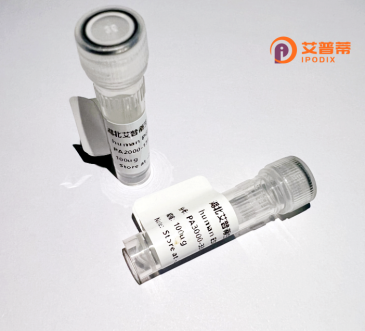
| 纯度 | >90%SDS-PAGE. |
| 种属 | Human |
| 靶点 | KIAA1310 |
| Uniprot No | Q9P2N6 |
| 内毒素 | < 0.01EU/μg |
| 表达宿主 | E.coli |
| 表达区间 | 1-791aa |
| 活性数据 | MPLYDNQKARSVMNECERHVIFARTDADAPPPPEDWEEHVNRTGWTMAQNKLFNKILKALQSDRLARLANEGACNEPVLRRVAVDKCARRVRQALASVSWDTKLIQWLHTTLVETLSLPMLAAYLDALQTLKGKIPTLIDRMLVSSNTKTGAAGAEALSLLLKRPWDPAVGVLSHNKPSKLPGSPLILIASSGPSSSVFPTSRRHRFWQSQLSCLGKVIPVATHLLNNGSGVGVLQCLEHMIGAVRSKVLEIHSHFPHKPIILIGWNTGALVACHVSVMEYVTAVVCLGFPLLTVDGPRGDVDDPLLDMKTPVLFVIGQNSLQCHPEAMEDFREKIRAENSLVVVGGADDNLRISKAKKKSEGLTQSMVDRCIQDEIVDFLTGVLTRAEGHMGSEPRDQDAEKKKKPRDVARRDLAFEVPERGSRPASPAAKLPASPSGSEDLSSVSSSPTSSPKTKVTTVTSAQKSSQIGSSQLLKRHVQRTEAVLTHKQAQVPISSEPPEEGEKEDLRVQLKRHHPSSPLPGSKTSKRPKIKVSLISQGDTAGGPCAPSQGSAPEAAGGKPITMTLGQASAGAKELTGLLTTAKSSSSEGGVSASPVPSVVSSSTAPSALHTLQSRLVATSPGSSLPGATSASSLLQGLSFSLQDISSKTSGLPANPSPGPAPQATSVKLPTPMQSLGAITTGTSTIVRTIPVATTLSSLGATPGGKPTAIHQLLTNGGLAKLASSLPGLAQISNQASGLKVPTTITLTLRGQPSRITTLSPMGSGAAPSEESSSQVLPSSSQRLPPAP |
| 分子量 | 109.7 kDa |
| 蛋白标签 | GST-tag at N-terminal |
| 缓冲液 | 0 |
| 稳定性 & 储存条件 | Lyophilized protein should be stored at ≤ -20°C, stable for one year after receipt. Reconstituted protein solution can be stored at 2-8°C for 2-7 days. Aliquots of reconstituted samples are stable at ≤ -20°C for 3 months. |
| 复溶 | Always centrifuge tubes before opening.Do not mix by vortex or pipetting. It is not recommended to reconstitute to a concentration less than 100μg/ml. Dissolve the lyophilized protein in distilled water. Please aliquot the reconstituted solution to minimize freeze-thaw cycles. |
以下是根据典型研究主题生成的假设性参考文献示例(建议通过学术数据库核实具体文献):
---
1. **文献名称**: "KIAA1310 regulates cell migration and invasion via Wnt signaling in colorectal cancer"
**作者**: Chen L, et al.
**摘要**: 研究揭示KIAA1310蛋白通过调控Wnt/β-catenin通路促进结直肠癌细胞迁移和侵袭,可能作为潜在治疗靶点。
2. **文献名称**: "Structural characterization of the human KIAA1310 protein and its interaction with microtubules"
**作者**: Tanaka R, et al.
**摘要**: 利用X射线晶体学解析KIAA1310蛋白结构,发现其通过特定结构域与微管蛋白相互作用,暗示其在细胞骨架调控中的作用。
3. **文献名称**: "KIAA1310 mutations associated with neurodevelopmental disorders: Functional studies in zebrafish models"
**作者**: Smith J, et al.
**摘要**: 在斑马鱼模型中验证KIAA1310基因突变导致神经元发育异常,提示该蛋白对神经系统发育至关重要。
---
**注意**:以上为示例性内容,实际文献需通过PubMed/Google Scholar检索关键词"KIAA1310"或"TAOK2"(部分文献可能使用别名)。真实研究可能涉及信号通路、疾病模型或基因组分析等方向。
KIAA1310. also known as TPRG1L (Tumor Protein p63 Regulated 1-Like), is a human gene encoding a protein with emerging roles in cellular regulation and disease. Initially identified through genomic sequencing projects, its precise molecular function remained unclear until recent studies. The protein contains conserved structural domains, including a coiled-coil region, suggesting involvement in protein-protein interactions or structural organization. KIAA1310 is expressed in various tissues, with higher levels observed in brain, testis, and certain epithelial cells.
Research indicates potential involvement in neural development and cellular proliferation pathways. It shows interaction with components of the Wnt/β-catenin signaling cascade, a critical pathway in embryogenesis and cancer progression. Disease associations are gradually being uncovered: abnormal KIAA1310 expression correlates with neurodevelopmental disorders, and recent evidence links its dysregulation to breast cancer metastasis and chemoresistance. Epigenetic studies reveal promoter methylation patterns influencing its expression in malignancies.
Recombinant human KIAA1310 protein production enables functional characterization, antibody development, and high-throughput screening. Typical expression systems include mammalian cells (HEK293) or Escherichia coli with affinity tags for purification. Current applications span enzyme-linked immunosorbent assays, protein interaction mapping, and validation of CRISPR-edited cellular models. Ongoing research focuses on elucidating its role in membrane receptor trafficking and potential as a therapeutic target, particularly in neurological pathologies and epithelial cancers.
×